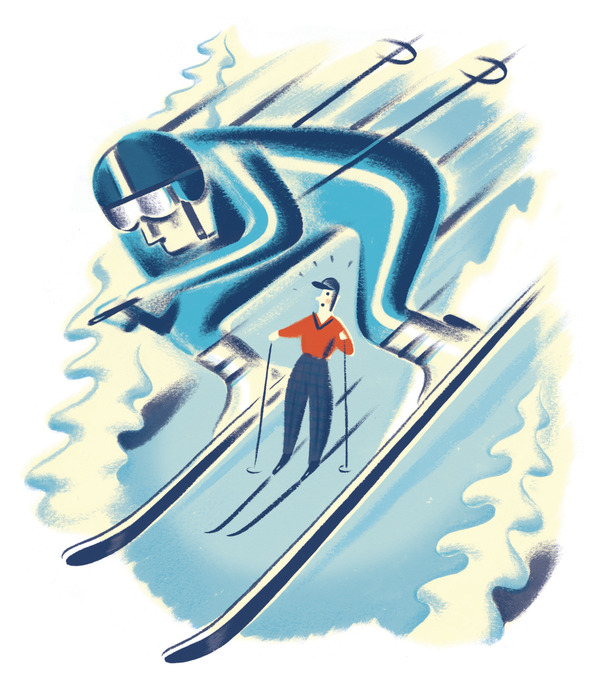The Local newsletter is your free, daily guide to life in Colorado. For locals, by locals.
Ski areas are like sports teams: Everyone has a favorite to which they are fiercely loyal. So when I mention I get my turns in at Eldora, responses are as pointed as a pair of old Rossignols. Sometimes it’s a knowing nod; our state’s frequent upslope storms can leave Eldora knee-deep in powder when the rest of the state is dry. Others wrinkle their noses and derisively retort, “Eldora? But it’s so small and windy!” Without fail, my fellow Coloradans also remark on Eldora’s rustic feel. It is not an affectation. Half of Eldora’s 10 lifts date to 1980 or earlier; the main lodge resembles the dilapidated hotel in Hot Tub Time Machine; and only by the most creative route could you string together a three-mile-long run with 1,600 feet of vertical drop, a stat Eldora claims on its website. Eldora Mountain Resort knows all of this; the management feels it acutely with every “Oldora” joke cracked over an après-ski beer.
Today, despite its retro vibe, Eldora is straining to accommodate its visitors. Skiers and snowboarders frustrated with I-70 are looking elsewhere for untracked powder, and Eldora sits just 48 miles northwest of downtown Denver. Plus, in recent years the small resort has worked deals to be included in multiresort passes—Vail Resorts’ Epic Pass last year; the Rocky Mountain Super Pass Plus this coming season—making it even more accessible. Too accessible, in fact: On many peak weekends last year, visitors were turned away because the resort’s parking lots were full.
Which is why Eldora has been planning a major upgrade to modernize the area and absorb that growth. But ski area expansions are, almost by rule, contentious. Eldora’s situation may be similarly complicated: It’s the only daytrip-able ski area not located on I-70; its western boundary is roughly a mile from Indian Peaks Wilderness Area, one of the most popular wilderness areas in the United States; and the expansion could greatly affect quality of life for residents of Eldora and the larger town of Nederland.
Eldora’s proposal, which first must be approved by the U.S. Forest Service, could also change the overall snowsports experience in Colorado. As one of just eight areas in Colorado Ski Country USA’s “Gems” program, which highlights and preserves the sport’s heritage, Eldora represents the kind of unpretentious ski experience that is increasingly difficult to find. It’s the un-Vail. And so, in its attempts to modernize, Eldora must also fight to protect what draws people to it in the first place.
Eldora’s proposed overhaul is one of the most ambitious efforts in its 50-plus-year history. The area aims to replace three of its four major lifts and add up to two more; parking would grow by 560 spaces; one of its four restaurants would get a major renovation; and a new midmountain lodge would add a fifth eatery. Most important, Eldora would cut up to 15 new runs and increase vertical drop by 25 percent with ski area boundary adjustments to the south, toward Jenny Creek, and to the north, toward Middle Boulder Creek.
Despite this, Eldora’s planning director, Jim Spenst, scoffs at the use of the word “expansion.” At its most ambitious, he says, Eldora would add fewer than 100 acres of total new terrain. “I don’t consider a 100-acre boundary adjustment an expansion,” he says. But what Spenst downplays is the most controversial aspect of the proposed face-lift, which was included in Eldora’s 2011 master plan. The northern boundary adjustment would bring a new lift, called Placer, and associated snowmaking equipment down within a few yards of Middle Boulder Creek, which feeds Boulder’s drinking water supply and is a migration corridor for elk and moose. The lift base and a new maintenance bridge across the creek would be half a mile from the tiny town of Eldora and just 300 feet from the main parking lot at the popular Hessie trailhead that leads to the Indian Peaks Wilderness Area.
Opponents point out that the ski area has long had an expansionist mindset. “They wanted to bring lifts down to Middle Boulder Creek back in the ’60s,” says Dave Hallock, a conservation planner, 35-year Eldora resident, and member of the Middle Boulder Creek Coalition, an association of area residents and environmental groups that oppose the boundary adjustments. “In the ’80s, they wanted on-site lodging [which was conditionally approved but never came to fruition]. In the ’90s, it was an [approved] Indian Peaks expansion.
“But for years now, the attitude in Eldora toward the ski area has been live and let live,” says Hallock, who has personally opposed past expansions. “It’s been a ‘they’re in their valley and we’re in our valley’ attitude.” But with Eldora’s bid to expand beyond existing boundaries, he’s adamant: “We want a line in the sand.”
Eldora Mountain Resort opened in 1962, a boom time for the sport of skiing; in the ’50s and ’60s, no fewer than seven areas opened on the Front Range alone, including Geneva Basin, Ski Broadmoor, and Squaw Pass. Skiers flocked to these resorts because they were close, cheap, and didn’t require a harrowing drive over Loveland Pass. Then the Eisenhower Tunnel opened.
As cars began streaming under the Continental Divide in 1973, headed toward Vail, newly opened Copper Mountain, and other ski areas, business to Front Range slopes plummeted. Only Eldora and Loveland—which opened in 1936—still exist today. Survival hasn’t been easy. Eldora struggled in the ’80s, failing to even open during the 1986-87 season because of changes in management and financial issues. Salvation, of a sort, came in the early 1990s, when Eldora was purchased by a moneyed trio of ski enthusiasts. But while Eldora’s finances stabilized, it got stuck in time. The ski industry went through a rapid round of consolidations in the ’90s that saw resorts competing to draw visitors with ever-more-impressive amenities. Eldora, however, added only a few trails, one lift, and a new day lodge.
Eldora Mountain Resort’s complicated relationship with the nearby towns of Eldora and Nederland hasn’t helped its business interests, either. In the resort’s early days, its managers were locals who did their parts to engage the towns. Changes in ownership and a ’90s-era lawsuit filed against Boulder County over maintenance and upgrades on Shelf Road (the only road leading to the ski resort) have led to a strained connection. Payson Sheets, an anthropology professor at the University of Colorado Boulder whose family has owned a cabin in Eldora since 1945, says that about 40 years ago, the town actually unincorporated itself to ensure it couldn’t be turned into a Telluride-style base area. And Nederland merchants say the ski area provides only a small benefit to them, as most of their revenue is generated in the summer from Indian Peaks Wilderness visitors.
That said, locals do patronize the resort—and, in moments of weakness, acknowledge the thinness of some of their concerns about Eldora’s proposed expansion. The town of Eldora has roughly 150 year-round residents, so snowmaking noise would fall on few ears. The ski area is already plainly visible from parts of the Indian Peaks Wilderness Area, which gets most of its use in June, July, and August. And several locals admit the city of Nederland and the Colorado Department of Transportation could do a better job of mitigating backups at Nederland’s lone traffic circle, which would lessen the impact of the ski resort’s traffic.
Wildlife habitat and water quality may be more pressing concerns. But Spenst points out it’s a condition of the area’s 30-year special permit lease with the Forest Service, which owns roughly three-quarters of the land the ski area operates on, that Eldora mitigate all environmental impacts according to strict federal regulations. Still, Eldora’s critics are concerned the Forest Service isn’t looking closely enough at the expansion proposal. Their apprehensions center on the Draft Environmental Impact Statement (DEIS), a kind of guiding document for the ultimate decision on the expansion. Hallock and others mention several problems with the DEIS, which they say the Forest Service isn’t addressing.
To wit: Eldora is notorious for “wind hold” situations that can shut down lift access to more than half the mountain. Spenst says the proposed Placer chair wouldn’t be as affected by high winds, but a planned wind-speed study by the Forest Service was never done. Marcia Gilles, spokesperson for the Forest Service, says the Forest Service determined the study wasn’t necessary, but it reserves the right to change its mind if expert reviews of the DEIS or public comments suggest otherwise.
More broadly, citizens are alarmed by the fact that the Forest Service doesn’t always write its own DEIS reports; it sometimes relies on consultants. The Eldora DEIS was written by the SE Group, a development consulting firm that specializes in resort communities, which also wrote Eldora’s 2011 master plan. Gilles says federal regulations expressly permit contractors to work for both sides. The DEIS says SE Group filed a disclosure stating it has no stake in the outcome of the project, and “no conflict of interest exists.”
All of that makes the wary opposition even warier. The opponents of the expansion plan I spoke with emphasized they’re not against improvements—so long as they stay within existing boundaries. But the fear in Eldora, says longtime resident Joe McDonald, is that the expansion is merely a prelude to further landgrabs: “Everyone is suspicious of the next step.” In reality, though, the next steps are for the Forest Service to make its long-awaited decision—expected in early 2015—and for Eldora to determine exactly how it will move forward.
For a skier, there’s nothing like the promise of a fat powder stash to get the heart racing. After an unassuming start to the 2013-14 ski season, January and February saw a series of steady storms that dropped two to eight inches of snow at Eldora every few days, covering bony glades and wind-scoured slopes with swirls of fluffy white frosting.
On one busy Saturday morning, the crowds were funneling onto the Corona run, which meant the refuge of Eldora’s Brian’s Glades—a large triangle of trees uncut by slopes in the middle of the resort—was the place to be. The terrain there drops away gently, the trees thin slightly, and arcing turns between the pines feels like skiing on clouds. There was not one person in sight. The only sound was the breeze through the treetops and the sound of my breath.
This piece of heaven is the site of a proposed new run at Eldora. Tentatively called C-1 in the DEIS, the slope would add exactly the kind of intermediate terrain Eldora says it needs and drop about 400 more vertical feet down to Middle Boulder Creek. From the bottom, skiers and boarders would be able to ride a new high-speed, six-person lift back to the top for another run.
It sounds great—in theory. Better technology, more terrain, faster equipment. But to get those things, we’ll have to give up the Brian’s Glades’ powder stash—and potentially create other issues for the environment and area residents. Faster lifts and more runs mean easier skiing for everyone, but those few solitary turns in the trees and the soft, static whoosh of my edges in fresh-fallen powder are the things great skiing is made of. Yes, Eldora must grow and change to survive—any business does—but I have to say, I’m kind of fond of the old girl just the way she is.
Joe Lindsey is a Boulder-based freelance writer. Email him at letters@5280.com.









